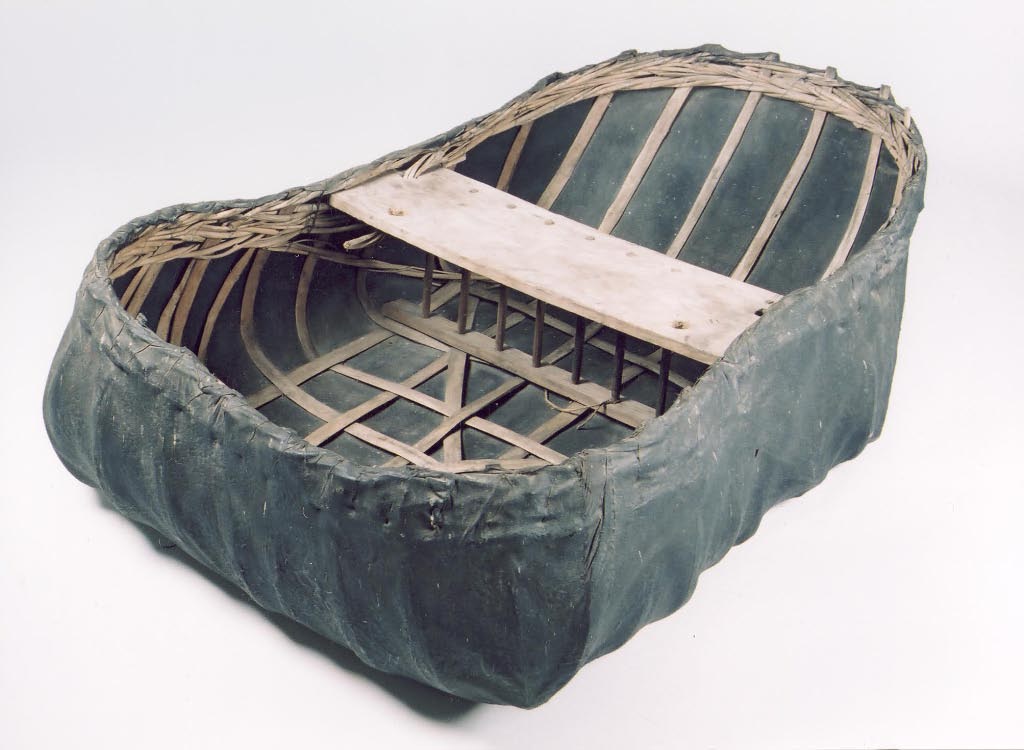 The Teifi coracle has been in use for over 200 years and is one of the few still in active use today. It has a similar design to the nearby Tywi coracle, but its traditional construction had some differences from the Tywi:
The Teifi coracle has been in use for over 200 years and is one of the few still in active use today. It has a similar design to the nearby Tywi coracle, but its traditional construction had some differences from the Tywi:
- the usage of cleft willow laths
- the use of a carry strap made from twisted hazel
- a plaited semi-circular reinforcing band found in the stern
The single transverse lath behind the seat - made from plaited willow - provides reinforcement to the boat structure and ensures the base of the coracle is flat.
The Teifi coracle was traditionally covered in animal hide. This was succeeded by flannel in the late 18th century/early 19th century, succeeded by calico. Some experimentation in recent times with man made fabrics such as cordura. The carry strap has also been modernised, using rubber tubing. Fibreglass is also used as a construction material.
The primary usage of the Teifi coracle was for net fishing. Teifi fishermen remain among the few to still hold licences to fish today, though this is restricted to tidal stretches of the river - fishing on other parts of the Teifi came to an end in the 1970s, when the last licenced fisherman stopped due to ill health. In a similar fashion to Tywi coracle netsmen, a net is drawn downstream between two coracles. Rod and line fishing has also taken place in the past.
Other usage of the Teifi coracle includes livestock rescue and sheep washing - photos of the latter exist. Teifi coracleman Bernard Thomas described to Sir Peter Badge that the coraclemen of Llechryd, in times of flood, would rescue livestock that had become stranded by the high waters.
The Teifi coracle is carried over the head rather than on the back or over the shoulder. The strap is positioned across the upper torso and the paddle - which has a claw crafted in to the top of the shaft - hooks under the seat and rests on the shoulder. This distributes the weight of the boat. Nets are carried on top of the coracle.
Well known Teifi coraclemakers include Bernard Thomas and Ronnie Davies. Bernard Thomas famously crossed the English Channel in the 1970s in a Teifi coracle, and the cushion he took with him to sit on during the 14 hour journey is now in the National Coracle Centre in Cenarth. By comparison, the fastest person to swim the English Channel took just under 7 hours.
The river has a long history of races. Until recently a 12-mile long Boxing Day race took place between Llechryd and Cardigan bridges. The most famous event is the annual regatta at Cilgerran, held as part of the annual, week long, Cilgerran River Festival. 2015 celebrates 65 years of the Cilgerran River Festival and coracle regatta, which has only been cancelled less than a handful of times in it's long history due to heavy flooding.
Some content provided from "Coracles of the World" by kind permission of Sir Peter Badge. Photography credits: Amgueddfa Cymru – National Museum Wales
Missing a credit? Error in our information? Let us know so we can update this
